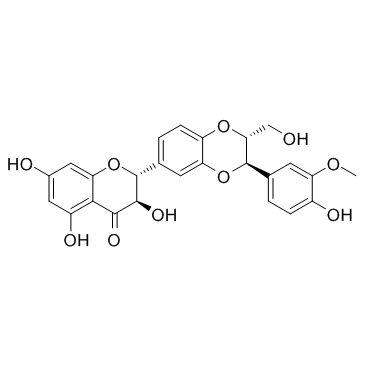Silymarin

Silymarin structure
|
Common Name | Silymarin | ||
|---|---|---|---|---|
| CAS Number | 22888-70-6 | Molecular Weight | 482.436 | |
| Density | 1.5±0.1 g/cm3 | Boiling Point | 793.0±60.0 °C at 760 mmHg | |
| Molecular Formula | C25H22O10 | Melting Point | 164-174°C | |
| MSDS | Chinese USA | Flash Point | 274.5±26.4 °C | |
| Symbol |

GHS07 |
Signal Word | Warning | |
|
High-performance thin-layer chromatography linked with (bio)assays and mass spectrometry - a suited method for discovery and quantification of bioactive components? Exemplarily shown for turmeric and milk thistle extracts.
J. Chromatogr. A. 1394 , 137-47, (2015) Extraction parameters, chemical fingerprint, and the single compounds' activity levels were considered for the selection of active botanicals. For an initial survey, the total bioactivity (i.e., total reducing capacity, total flavonoids contents and free radi... |
|
|
The in-vitro effect of complementary and alternative medicines on cytochrome P450 2C9 activity.
J. Pharm. Pharmacol. 66(9) , 1339-46, (2014) The aim of this study is to establish the inhibitory effects of 14 commonly used complementary and alternative medicines (CAM) on the metabolism of cytochrome P450 2C9 (CYP2C9) substrates 7-methoxy-4-trifluoromethyl coumarine (MFC) and tolbutamide. CYP2C9 is ... |
|
|
Effect of silibinin on the pharmacokinetics of nitrendipine in rabbits.
Eur. J. Drug Metab. Pharmacokinet. 39(4) , 277-81, (2014) Silibinin, a major constituent of silymarin, is widely used for its hepatoprotective effects. This study investigated the effect of silibinin on the pharmacokinetics of oral nitrendipine in rabbits. In first set of experiment, male New Zealand rabbits were pr... |
|
|
Quality assessment and antiplasmodial activity of West African Cochlospermum species.
Phytochemistry 119 , 51-61, (2015) The present study focuses on development of phytochemical methods for quality assessment of two West-African Cochlospermum species (Cochlospermum planchonii and Cochlospermum tinctorium) traditionally used for malaria treatment in Burkina Faso. Antimalarial a... |
|
|
Interaction between oblongifolin C and UDP-glucuronosyltransferase isoforms in human liver and intestine microsomes.
Xenobiotica 45 , 578-85, (2015) 1. Oblongifolin C (OC) is a potential natural anticancer candidate, and its metabolic profile has not yet been established. 2. One major OC glucuronidation metabolite (OCG) has been identified in a pool of human liver microsomes (HLMs). Chemical inhibition ex... |
|
|
Engineered silybin nanoparticles educe efficient control in experimental diabetes.
PLoS ONE 9(7) , e101818, (2014) Silybin, is one imminent therapeutic for drug induced hepatotoxicity, human prostate adenocarcinoma and other degenerative organ diseases. Recent evidences suggest that silybin influences gluconeogenesis pathways favorably and is beneficial in the treatment o... |
|
|
Media effects on the mechanism of antioxidant action of silybin and 2,3-dehydrosilybin: role of the enol group.
J. Org. Chem. 78(18) , 9102-12, (2013) Silybin (SIL) and 2,3-dehydrosilybin (DHS) are constituents of milk thistle extract (silymarin) applied in the treatment of cirrhosis, hepatitis, and alcohol-induced liver disease. The molecular mechanism of their action is usually connected with antioxidant ... |
|
|
Isolation and purification of diastereoisomeric flavonolignans from silymarin by binary-column recycling preparative high-performance liquid chromatography.
J. Sep. Sci. 37(17) , 2300-6, (2014) Silymarin extracted from Silybum marianum (L.) Gaertn consists of a large number of flavonolignans, of which diastereoisomeric flavonolignans including silybin A and silybin B, and isosilybin A and isosilybin B are the main bioactive components, whose prepara... |
|
|
Antiviral activity of silymarin against chikungunya virus.
Sci. Rep. 5 , 11421, (2015) The mosquito-borne chikungunya virus (CHIKV) causes chikungunya fever, with clinical presentations such as severe back and small joint pain, and debilitating arthritis associated with crippling pains that persist for weeks and even years. Although there are s... |
|
|
In vivo absorption comparison of nanotechnology-based silybin tablets with its water-soluble derivative.
Drug Dev. Ind. Pharm. 41 , 552-9, (2015) In this study, the in vivo oral absorption of a nanocrystal tablet formulation of a BCS II poorly water-soluble drug was compared with that of its water-soluble salt form. Silybin is used as the model drug, and its nanosuspension was prepared by high-pressure... |